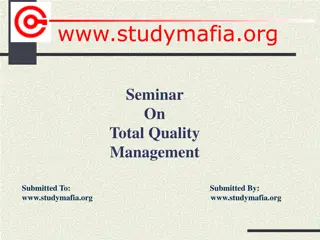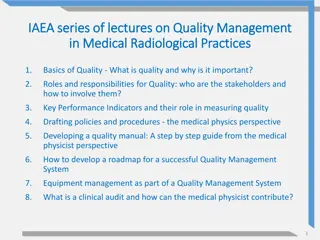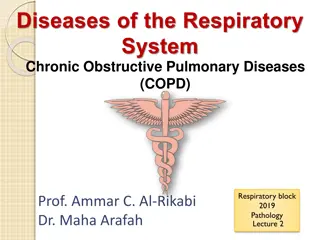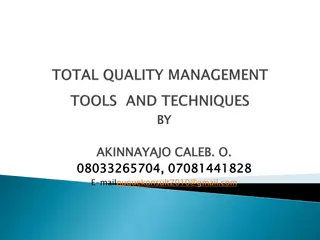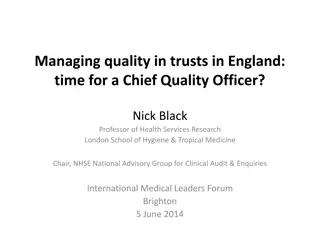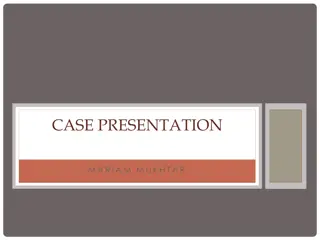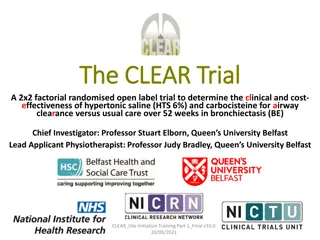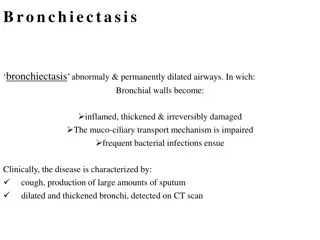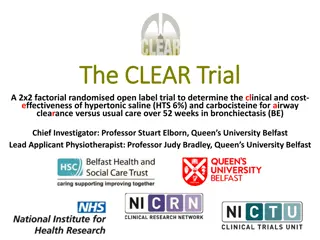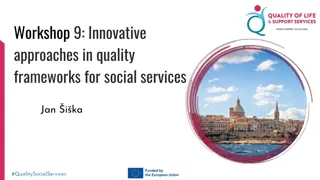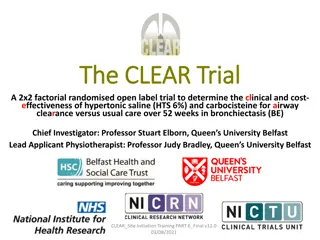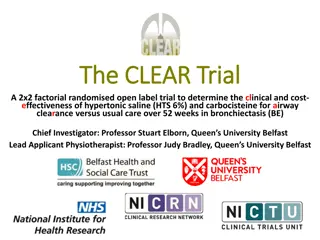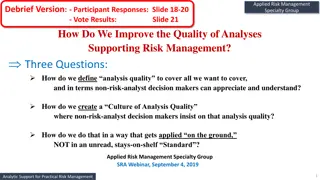Improving Life Quality with Bronchiectasis Management
Bronchiectasis is a chronic respiratory condition that can impact breathing and quality of life. This case study explores a 65-year-old man's journey with bronchiectasis, including symptoms, treatments like physiotherapy and medication, and self-management strategies for a better quality of life. The patient's proactive approach, support system, and adherence to treatment contribute to managing the condition effectively and avoiding hospitalizations. Regular check-ups, avoiding triggers like cigarette smoke, and staying prepared with medications are key aspects highlighted in the case study.
Download Presentation

Please find below an Image/Link to download the presentation.
The content on the website is provided AS IS for your information and personal use only. It may not be sold, licensed, or shared on other websites without obtaining consent from the author. Download presentation by click this link. If you encounter any issues during the download, it is possible that the publisher has removed the file from their server.
E N D
Presentation Transcript
CAN I LIVE BETTER WITH BRONCHIECTASIS? Pulmonology and Respiratory Medicine Department, Medical Faculty of Sebelas Maret University / Dr. Moewardi General Hospital Surakarta 2017
INTRODUCTION Bronchiectasis is chronic disease with lifetime breathing difficulties Low life quality, heightened anxiety and depression Bronchiectasis prevalence: WILL LIFE QUALITY OF BRONCHIECTASIS PATIENTS IMPROVE? In United States (2005) 53 cases/100.000 people (0,053%) Data from Hospital in bronchiectasis in 221 (1.01%) of 11.018 inpatients dr.Sutomo 1990 Public reported 2
CASE REPORT CASE REPORT 65-year old man with phlegm cough since 8 years ago. The phlegm is white yellowish. Dyspnea occurs when coughing phlegm. Patient has regular check-up to doctor, with antibiotic, bronchodilator and mucolytic exercise are part of his routine. After therapy, phlegm cough decreases and patient can do his activity. therapy. Physiotherapy and Anti-TB drug history: ten years ago and stated recovered. Denied smoking history Denied systemic history Denied pertussis history inflammation 3
MSCT scan thorax non contrast Conducted in dr.Moewardi Hospital Solo September 8, 2016 signet ring appereances and air fluid level 4
SPIROMETRY TEST : % VC % FVC % FEV1 FEV 1% FEV 1% increase post bronchodilator = 80 ml equal to 13,5% = 63,82% = 59,68% = 48,86% = 67,69% Sputum culture: Enterobacter cloacae spp AFB sputume negative/negative/negative : Xpert MTb Rif MTb non detected : MEDIUM RESTRICTION MILD OBSTRUCTION 5
Patients statements about his illness : I must find out about my illness and what triggers the recurrence I do postural drainase because it helps relieving my problem I must always prepare medicine at home I always avoid cigarette smoke because it worsens my illness My family especially my children really support my medication I keep the telephone number of the doctor that treats me and I can contact him at any time if trouble occurs to my illness I have not been hospitalized ever since this illness 6
Patient is using inhaler Patient is conducting postural drainase 7
Therapy of antibiotic, bronchodilator, mucus clearence, physiotherapy & regular exercise Patient s obedience in disease management is associated with self- management program given by the doctor SELF EFFICACY Can patient have better life quality? 8
DI DISCUSSION SCUSSION Patient s obedience in disease management is associated with self-management program given by the doctor Patients can adjust therapy, behavior and environment based on the knowledge given by the medics in order to have the knowledge and skill to treat themselves 9
DIS DISCUSSION CUSSION Factors prognosis smoking, negative gram organism especially Eschericia colli & Pseudomonas aeruginosa & value FEV 1% and low FVC related of to bad life quality and are bronchiectasis patient 10
CONCLUSION CONCLUSION Patient therapy. Regular self-management along with self-awareness improve patient s life quality. got adequate education and 11
Rererences Iseman MD, Chan E. Bronchiectasis. In: Mason M, Nadel J, Murray J, editors. Murray and Nadel s Textbook of Respiratory Medicine. 5th ed. Philadelphia: Elseiver Inc; 2010. p. 1023-46. 1. Rahmatulah P. bronchiectasis. Jakarta : Balai Penerbit FK UI. 2006. p. 234-41. 2. Weyker D, Edelsberg J, Oster G, Tino G. Prevalence and economic burden of bronchiectasis. Clin Pulm Med. 2005:12:205-9. 3. Lavery KA, O Neill B, Parker M, Elborn JS, Bradley JM. Expert patient self-management program versus usual care in bronchiectasis: a randomized controlled trial. Arch Phys Med Rehabil. 2011;92:1194-201. 4. Quittner AL, O Donnell AE, Salathe MA, et al. Quality of Life Questionnaire-Bronchiectasis: final psychometric analyses and determinationof minimal important difference scores. Thorax. 2014;0:1 9. 5. Carolyn BW, Paul WJ, Catherine JO, Peter JC, Robert W. Validation of the St. George s Respiratory Questionnaire in Bronchiectasis. Am J Respir Crit Care Med. 1997;156:536-41. 6. Jones P. St. George Respiratory Questionnare manual. [Cited 2016 Oct15th]. Available from: http://thoracic.org/questionnare.html. 7. Loebinger MR, Wells AU, Hansell DM, et al. Mortality in bronchiectasis : a longterm study assessing the factors influencing survival. European Respiratory Journal. 2009;34:843-49. 8. Lorig KR, Sobel DS, Ritter PL, Laurent D, Hobbs M. Effect of a self management program for patients with chronic diseases. [Cited 2016 Oct15th]. Available from: http://patienteducation.stanford.edu/research/secd6. html. 9. Hui Yu S, Min Gou A,Juan Zhang X. Effect of self management education on quality of live of patient with chronic obstructive pulmonary diseases. International of Jonal Nursing Sciences. 2014;1:53-7. 10. 12
THANK YOU 13


